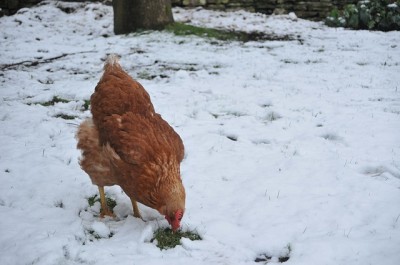
Preparing the chicken coop for winter should be at the top of any homesteading to-do list. A well-maintained coop will help prevent illnesses in your flock and keep your chickens happy enough to continue providing eggs for your table.
Winter often finds us with frozen water buckets, more cleaning than usual and cranky hens, but taking care of a few fall chores can make overwintering much easier – and make it far more likely your flock will continue producing eggs.
1. Prepping the coop
After every snowfall I am reminded there is a slight gap in the hinged door that rests on top of our coop’s nesting boxes. That results in a small snow drift that materializes and scares the hens from using the far west nesting box until I clean it out. A few minutes with a caulking gun will ensure that doesn’t happen again this winter. Seal crevices, tighten screws and make sure doors close flush with the coop walls.
Now is also the time to clean the vents that allow air to circulate through the coop and clean debris off the outside walls and roof. In addition to general cleaning and maintenance, determine if your building would benefit from extra protection from the elements in the form of wind breaks, wraps or extra insulation.
2. Cleaning the coop
Start winter with a fresh, clean coop. Remove old bedding from the entire coop, roosting areas, nesting boxes and runs. Before loading the hen house with fresh litter, dust the interior with diatomaceous earth (DE). This will deter unwanted pests from finding a home with your flock.
Some homesteaders choose to use sand in the winter as bedding, because it is easier to spot clean every few days. Others opt for the traditional straw or wood shavings that need to be replaced weekly during the more confining winter months. A few poultry owners choose to use the deep-litter method, which works by adding a fresh layer of bedding on top of the old to act as an extra layer of insulation and requires fewer full cleanings. Those using the deep-litter method must be sure the enclosure is well-ventilated. Decomposing droppings release ammonia, which can cause blindness and other illnesses if levels remain high inside the chicken coop. No matter which method you choose to use during the winter months, you must be certain that the enclosure remains dry. Bedding that is retaining high amounts of moisture will cause your birds respiratory issues.
3. Watering the flock
Keeping the flock healthy throughout the winter months has much to do with water. Too much water in the litter will cause disease in the birds, but too little fresh drinking water will do the same. Chickens will not break through the ice with their beaks, so you must provide water containers that are free from ice. For the busy homesteader, heated waterers are quite a timesaver. A heated pet bowl with a pet-safe cord will keep your flock drinking throughout the day, although the shallower pet bowls may need more frequent cleaning. For those who do not have electricity in their building, or choose not to risk a fire, changing the water frequently, two to three times a day when temperatures are below freezing, should be sufficient. Use thick plastic containers to delay ice build-up.
4. Lights on or off
There is much debate on whether you should provide a light for your chickens, whether for the sake of heat or the sake of artificial daylight for egg production. Much of the debate stems from the risk of fire that arises when heating or lighting a hen house. It takes just a few moments for a heat lamp that has been knocked over to start a fire inside the coop. Heat lamps, or brooding lamps, should not be used in most chicken coops. They produce too much heat and also can stress the birds in the colder winter months.
In most areas, adequate lighting can be achieved with one 40-watt bulb with a reflector for every 250 square feet. Using a timer to achieve 10 hours of daylight will encourage your flock to keep producing eggs while also providing them adequate time to rest.
5. Boredom busters
Poultry cooped up in the coop all day will quickly become bored. That’s where the trouble starts. They will begin pecking at each other, to the point of death in some instances, while others will find mischief in the nesting boxes by destroying precious eggs.
Keep the boredom at bay with a few additions to the coop. A produce bag filled with fresh greens hung from the ceiling works as a healthy treat as well as a distraction from pecking at each other. Similarly, broccoli crowns, cabbages and other vegetables can be hung as a treat as can more traditional suet bags and seed blocks.
link to the article content:

